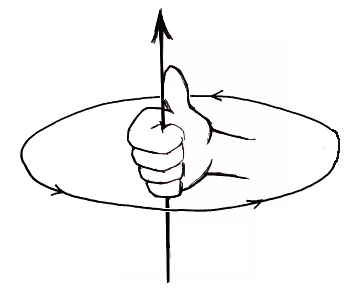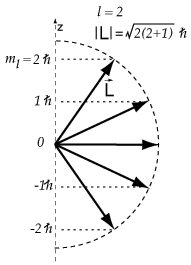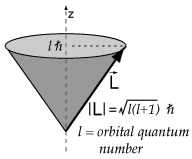Quick Review
 In three dimensions, a particle can have angular momentum. Angular momentum is most often associated
with rotational motion and orbits. For a classical particle
orbiting a center, we define the orbital angular momentum L of a
particle about an axis as L =
mr2ω, where r is the
perpendicular distance of the particle from the axis of rotation and
ω is its angular speed, in radians/s. Angular momentum is a vector. The magnitude of the
orbital angular momentum of the particle is L = mrvperp =
mr2ω. Here vperp is the component of the
particles velocity perpendicular to the axis of rotation. The
direction of the angular momentum is given by
the right-hand rule. The angular momentum of isolated systems is conserved. If no external torque acts on a system of interacting objects, then their
total angular momentum of the system is constant. The angular momentum of
a classical particle can have any magnitude and point in any direction.
In three dimensions, a particle can have angular momentum. Angular momentum is most often associated
with rotational motion and orbits. For a classical particle
orbiting a center, we define the orbital angular momentum L of a
particle about an axis as L =
mr2ω, where r is the
perpendicular distance of the particle from the axis of rotation and
ω is its angular speed, in radians/s. Angular momentum is a vector. The magnitude of the
orbital angular momentum of the particle is L = mrvperp =
mr2ω. Here vperp is the component of the
particles velocity perpendicular to the axis of rotation. The
direction of the angular momentum is given by
the right-hand rule. The angular momentum of isolated systems is conserved. If no external torque acts on a system of interacting objects, then their
total angular momentum of the system is constant. The angular momentum of
a classical particle can have any magnitude and point in any direction.
Please click
here for a 3D review of the right-hand rule!
Quantum mechanics predicts that all angular momentum is quantized
in magnitude as well as in direction.
If we measure the magnitude of the angular momentum, we will only
measure discrete values, and if we choose a coordinate system and
measure its projection along one of the coordinate axis, we will only
measure discrete values.
Orbital angular momentum is quantized.
 The possible values that we can measure for the square of the magnitude of the
orbital angular momentum are L2 = l(l + 1)ħ2. It is customary to give L2,
and not L = l(l + 1))½ħ.
The quantum number l is the label we use to identify the different
values we can measure; l is a non-negative integer, l = 0, 1, 2, ... .
The possible values that we can measure for the square of the magnitude of the
orbital angular momentum are L2 = l(l + 1)ħ2. It is customary to give L2,
and not L = l(l + 1))½ħ.
The quantum number l is the label we use to identify the different
values we can measure; l is a non-negative integer, l = 0, 1, 2, ... .
The projections of the angular momentum along any axis are also
quantized. We can know the magnitude and the projection along
any one axis at the same time.
These measurements are compatible.
The possible projections or components along any axis, for example
the z-axis, are quantized, we have Lz = mħ.
The quantum number m is an integer, and m can take on values from -l to l in integer
steps. Given l, there are 2l + 1 possible values for m.
The orbital angular momentum vector L is never precisely
aligned with any coordinate axis.
Example:
Assume we have measured the magnitude of the orbital angular momentum
and found L = (l(l + 1))½ħ with l = 2. Then the
magnitude of the angular momentum vector is L = 6½ħ = 2.45ħ.
It's possible projections along the z-axis are mħ = -2ħ, -1ħ, 0,
1ħ, 2ħ. The largest projection is 2ħ, which is smaller than
2.45ħ, the value we would get if the vector could point in the
z-direction.
 If we measure Lz = 2ħ, then we know that L lies on a cone,
as shown on the right, but we do not know its projections along the x and y axes.
The orbital angular momentum vector L is never
precisely aligned with a coordinate axis.
If we measure Lz = 2ħ, then we know that L lies on a cone,
as shown on the right, but we do not know its projections along the x and y axes.
The orbital angular momentum vector L is never
precisely aligned with a coordinate axis.
The components of the orbital angular momentum along different axes are
incompatible observables. Lx, Ly, and Lz
cannot be known simultaneously. If we measure the component of the
angular momentum along one axis, we lose information about the components along
the other axes. We do, however, not lose information about the magnitude
of the angular momentum.
Problem:
We have measured the square of the orbital angular momentum of a particle and
have found the value L2 = 30ħ2. If we now measured the
z-component of the orbital angular momentum Lz, what are the possible
outcomes of the measurement?
Solution:
- Reasoning:
The measurements are compatible.
- Details of the calculation:
L2 = l(l + 1)ħ2, so l = 5.
The possible outcome of a measurement of Lz are Lz =
mħ, with m taking on values from -l to +l in integer steps.
The possible outcomes therefore are mħ = -5ħ, -4ħ, -3ħ, -2ħ, -1ħ, 0, 1ħ, 2ħ,
3ħ, 4ħ, 5ħ.
Problem:
We have measured the square of the orbital angular momentum of a particle and
have found the value L2 = 30ħ2. We measured the
z-component of the orbital angular momentum and found Lz = 0.
If we now measured the x-component of the orbital angular momentum Lx, what are the possible
outcomes of the measurement?
Solution:
- Reasoning:
The measurements L2 and Lx are compatible, and l = 5 (see
previous problem).
- Details of the calculation:
The possible outcome of a measurement of Lx are Lx =
mħ, with m taking on values from -l to +l in integer steps.
The possible outcomes therefore are mħ = -5ħ, -4ħ, -3ħ, -2ħ, -1ħ, 0, 1ħ, 2ħ,
3ħ, 4ħ, 5ħ.
But the measurements of Lx and Lz are incompatible.
After measuring Lx, we have lost the information about Lz.
Problem:
Assume the orbital angular momentum quantum number l of a particle is l = 2.
(a) How many angles can the angular momentum L make
with the z-axis?
(b) Calculate the value of the smallest angle.
Solution:
- Reasoning:
There are 2l + 1 possible values of m, or 2l +1 possible projections of L
onto the z-axis.
- Details of the calculation:
(a) L can make 5 different angles
with the z-axis.
(b) The largest positive projection yields the smallest angle. We have
cosθ = Lz/L = (mħ)/((l(l+1))½ħ).
The largest possible m is m = 2, so the smallest angle satisfies cosθ =
2/(√6) = 0.8165, θ = 35o.
 In three dimensions, a particle can have angular momentum. Angular momentum is most often associated
with rotational motion and orbits. For a classical particle
orbiting a center, we define the orbital angular momentum L of a
particle about an axis as L =
mr2ω, where r is the
perpendicular distance of the particle from the axis of rotation and
ω is its angular speed, in radians/s. Angular momentum is a vector. The magnitude of the
orbital angular momentum of the particle is L = mrvperp =
mr2ω. Here vperp is the component of the
particles velocity perpendicular to the axis of rotation. The
direction of the angular momentum is given by
the right-hand rule. The angular momentum of isolated systems is conserved. If no external torque acts on a system of interacting objects, then their
total angular momentum of the system is constant. The angular momentum of
a classical particle can have any magnitude and point in any direction.
In three dimensions, a particle can have angular momentum. Angular momentum is most often associated
with rotational motion and orbits. For a classical particle
orbiting a center, we define the orbital angular momentum L of a
particle about an axis as L =
mr2ω, where r is the
perpendicular distance of the particle from the axis of rotation and
ω is its angular speed, in radians/s. Angular momentum is a vector. The magnitude of the
orbital angular momentum of the particle is L = mrvperp =
mr2ω. Here vperp is the component of the
particles velocity perpendicular to the axis of rotation. The
direction of the angular momentum is given by
the right-hand rule. The angular momentum of isolated systems is conserved. If no external torque acts on a system of interacting objects, then their
total angular momentum of the system is constant. The angular momentum of
a classical particle can have any magnitude and point in any direction. The possible values that we can measure for the square of the magnitude of the
orbital angular momentum are L2 = l(l + 1)ħ2. It is customary to give L2,
and not L = l(l + 1))½ħ.
The quantum number l is the label we use to identify the different
values we can measure; l is a non-negative integer, l = 0, 1, 2, ... .
The possible values that we can measure for the square of the magnitude of the
orbital angular momentum are L2 = l(l + 1)ħ2. It is customary to give L2,
and not L = l(l + 1))½ħ.
The quantum number l is the label we use to identify the different
values we can measure; l is a non-negative integer, l = 0, 1, 2, ... . If we measure Lz = 2ħ, then we know that L lies on a cone,
as shown on the right, but we do not know its projections along the x and y axes.
The orbital angular momentum vector L is never
precisely aligned with a coordinate axis.
If we measure Lz = 2ħ, then we know that L lies on a cone,
as shown on the right, but we do not know its projections along the x and y axes.
The orbital angular momentum vector L is never
precisely aligned with a coordinate axis.